
Bikram Yoga is a system of hot yoga, a type of yoga as exercise, spread by Bikram Choudhury and based on the teachings of B. C. Ghosh, that became popular in the early 1970s. Classes consist of a fixed sequence of 26 postures, practised in a room heated to 105 °F (41 °C) with a humidity of 40%, intended to replicate the climate of India. The room is fitted with carpets and the walls are covered in mirrors. The instructor may adjust the students' yoga postures. Choudhury's teaching style was abrasive.

Ashtanga yoga is a style of yoga as exercise popularised by K. Pattabhi Jois during the twentieth century, often promoted as a dynamic form of medieval hatha yoga. Jois claimed to have learnt the system from his teacher Tirumalai Krishnamacharya. The style is energetic, synchronising breath with movements. The individual poses (asanas) are linked by flowing movements called vinyasas.
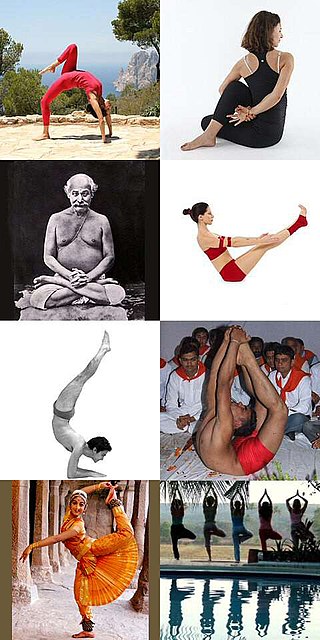
An āsana is a body posture, originally and still a general term for a sitting meditation pose, and later extended in hatha yoga and modern yoga as exercise, to any type of position, adding reclining, standing, inverted, twisting, and balancing poses. The Yoga Sutras of Patanjali define "asana" as "[a position that] is steady and comfortable". Patanjali mentions the ability to sit for extended periods as one of the eight limbs of his system. Asanas are also called yoga poses or yoga postures in English.
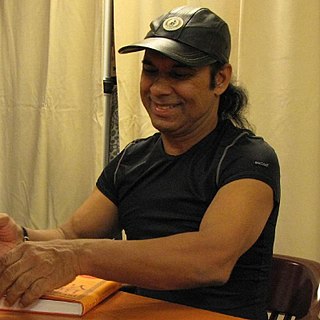
Bikram Choudhury is an Indian-American yoga guru, and the founder of Bikram Yoga, a form of hot yoga consisting of a fixed series of 26 postures practised in a hot environment of 40 °C (104 °F). The business became a success in the United States and then across the Western world, with a variety of celebrity pupils. His former wife Rajashree Choudhury assisted him in the yoga business.

Bālāsana or Child Pose, is a kneeling asana in modern yoga as exercise. Balasana is a counter asana for various asanas and is usually practiced before and after Sirsasana.

Shavasana, Corpse Pose, or Mritasana, is an asana in hatha yoga and modern yoga as exercise, often used for relaxation at the end of a session. It is the usual pose for the practice of yoga nidra meditation, and is an important pose in Restorative Yoga.

Tree pose or Vrikshasana is a balancing asana. It is one of the very few standing poses in medieval hatha yoga, and remains popular in modern yoga as exercise. The pose has been called iconic of modern yoga; it is often featured in yoga magazines, and practised in public displays such as for the International Day of Yoga.

Ustrasana, Ushtrasana, or Camel Pose is a kneeling back-bending asana in modern yoga as exercise.
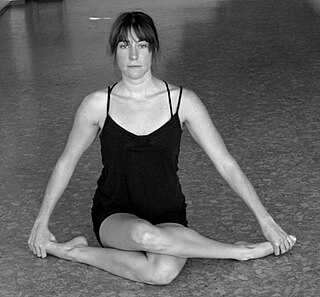
Yin Yoga is a slow-paced style of yoga, incorporating principles of traditional Chinese medicine, with asanas (postures) that are held for longer periods of time than in other yoga styles. Advanced practitioners may stay in one asana for five minutes or more. As conceptualized in the Taoist and Dharmic traditions, the sequences of postures are meant to stimulate the channels of the subtle body, known as meridians in Chinese medicine and as nadis in Hatha yoga.

Chaturanga Dandasana or Four-Limbed Staff pose, also known as Low Plank, is an asana in modern yoga as exercise and in some forms of Surya Namaskar, in which a straight body parallel to the ground is supported by the toes and palms, with elbows at a right angle along the body. The variation Kumbhakasana, Phalakasana, or High Plank has the arms straight.
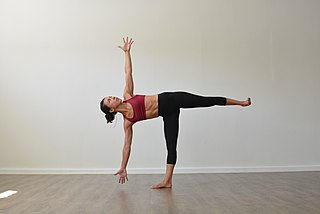
Ardha Chandrasana or Half Moon Pose is a standing asana in modern yoga as exercise.

Hot yoga is a form of yoga as exercise performed under hot and humid conditions, resulting in considerable sweating. Some hot yoga practices seek to replicate the heat and humidity of India, where yoga originated. Bikram Choudhury has suggested that the heated environment of Bikram Yoga helps to prepare the body for movement and to "remove impurities".
Bikram Choudhury made a series of claims that his yoga practice, Bikram Yoga, was under copyright and that it could not be taught or presented by anyone whom he had not authorized, starting in 2002. In 2011 Choudhury started a lawsuit against Yoga to the People, a competing yoga studio founded by a former student of Bikram's and with a location near one of the Bikram Yoga studios in New York. As a result of that lawsuit, the United States Copyright Office issued a clarification that yoga postures (asanas) could not be copyrighted in the way claimed by Bikram, and that Yoga to the People and others could continue to freely teach these exercises. In 2015, the Ninth Circuit Court of Appeals affirmed a lower court ruling that the Bikram Yoga Sequence was not copyrightable subject matter.

Core Strength Vinyasa Yoga is a style of yoga as exercise created by American yogini Sadie Nardini in 2006. Central to this style is a movement referred to as a 'wave' (softening). The structure of this practice includes a 7-step framework which is applied to each pose within a sequence. Nardini incorporates aspects of Kundalini Yoga, Sivananda Yoga, Anusara Yoga, Iyengar Yoga, and portions of movement sequences from Ashtanga Vinyasa Yoga. Maintaining an internal focus on joy in the moment is part of the practice philosophy. This style integrates postures with learnings from many disciplines including physics, biology, and geometry, influenced by the works of Leslie Kaminoff. It incorporates traditional yoga philosophy from the Yoga Sutras of Patanjali. It emphasizes muscles that are deep within the body and includes the use of 'waves' in order to enter and exit poses. Examples include physical moves that activate muscles close to the spine—such as psoas and quadratus lumborum in order to build support for the body from within before generating outward expression of that movement. The purpose of deep core focused poses in this practice is to improve and deepen breathing. This perspective differs from other styles in which the purpose of deep core work is to stabilize the back. In this practice, keeping belly soft and core strong improve breathing. "Belly Bonfire" breath is one example of a deep core breath technique that involves focus and target of attention and breath with softer abs. Pelvis is viewed as the body's physical center of gravity in this system.

Utthita Hasta Padangusthasana, Standing Big Toe Hold or Extended Hand-to-Big-Toe Pose is a standing balancing asana in modern yoga as exercise.

Yoga as exercise is a physical activity consisting mainly of postures, often connected by flowing sequences, sometimes accompanied by breathing exercises, and frequently ending with relaxation lying down or meditation. Yoga in this form has become familiar across the world, especially in the US and Europe. It is derived from medieval Haṭha yoga, which made use of similar postures, but it is generally simply called "yoga". Academic research has given yoga as exercise a variety of names, including modern postural yoga and transnational anglophone yoga.
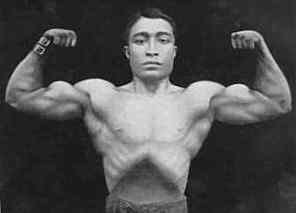
Bishnu Charan Ghosh was an Indian bodybuilder and Hathayogi. He was the younger brother of yogi Paramahansa Yogananda, who wrote the 1946 book Autobiography of a Yogi. In 1923, he founded the College of Physical Education, Calcutta. His writings influenced the development of modern yoga as exercise in India and Bikram Choudhury founded Bikram Yoga based on his teachings.

The standing asanas are the yoga poses or asanas with one or both feet on the ground, and the body more or less upright. They are among the most distinctive features of modern yoga as exercise. Until the 20th century there were very few of these, the best example being Vrikshasana, Tree Pose. From the time of Krishnamacharya in Mysore, many standing poses have been created. Two major sources of these asanas have been identified: the exercise sequence Surya Namaskar ; and the gymnastics widely practised in India at the time, based on the prevailing physical culture.

Postural yoga began in India as a variant of traditional yoga, which was a mainly meditational practice; it has spread across the world and returned to the Indian subcontinent in different forms. The ancient Yoga Sutras of Patanjali mention yoga postures, asanas, only briefly, as meditation seats. Medieval Haṭha yoga made use of a small number of asanas alongside other techniques such as pranayama, shatkarmas, and mudras, but it was despised and almost extinct by the start of the 20th century. At that time, the revival of postural yoga was at first driven by Indian nationalism. Advocates such as Yogendra and Kuvalayananda made yoga acceptable in the 1920s, treating it as a medical subject. From the 1930s, the "father of modern yoga" Krishnamacharya developed a vigorous postural yoga, influenced by gymnastics, with transitions (vinyasas) that allowed one pose to flow into the next.

Props used in yoga include chairs, blocks, belts, mats, blankets, bolsters, and straps. They are used in postural yoga to assist with correct alignment in an asana, for ease in mindful yoga practice, to enable poses to be held for longer periods in Yin Yoga, where support may allow muscles to relax, and to enable people with movement restricted for any reason, such as stiffness, injury, or arthritis, to continue with their practice.












































